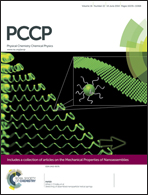Electronic structure at nanocontacts of surface passivated CdSe nanorods with gold clusters
Abstract
We report the electronic structure of free standing and gold attached passivated CdSe nanorods. The goal is to assess the changes at the nanolevel after formation of contacts with gold clusters serving as electrodes and compare the results with experimental observations [Steiner et al., Phys. Rev. Lett., 2005, 95, 056805]. It is interesting to note that upon attaching gold clusters, the nanorods shorter than 27 Å develop metallicity by means of metal induced gap states (MIGS). Longer nanorods exhibit a nanoscale Schottky barrier emerging at the center. For these nanorods, the interfacial region closest to the gold electrodes shows a finite density of states in the gap due to MIGS, which gradually decreases towards the center of the nanorod opening up a finite gap. Our theoretical results agree qualitatively with the experimental results of Steiner et al. This study attempts to identify the minimum length of a one-dimensional nanostructure to be used in an electronic device. An analysis of density of states and charge density brings out the role of hybridization of semiconductor states with metal states. Bader charge analysis indicates localized charge transfer from metal to semiconductor.


 Please wait while we load your content...
Please wait while we load your content...